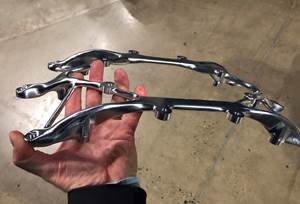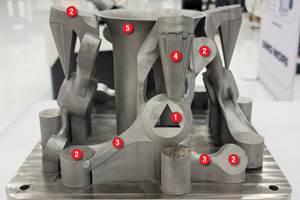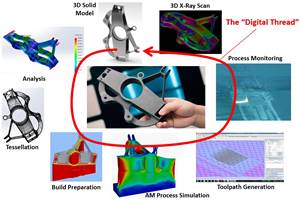The Challenge with AM Process Substitution
Making a one to one replacement of a part with AM is rarely cost-effective. Approaches like MFAM can improve the cost curve for AM, as Tim Simpson illustrates.
I have lost track of how many times I have stressed the economic (and technical) challenges companies face when attempting process substitutions with additive manufacturing (AM), or what I often refer to as “replicating” a part with AM. In short, everyone thinks a metal AM part is going to be cheaper than the machined, cast or forged version of the part (or as strong as the injection-molded part for those working in plastics) based on the hype, only to find that it is not. The “sticker shock” and disappointment that ensue often dampens the enthusiasm for AM and can undermine future AM investments, creating an uphill battle for AM.
The part in the training example that I discussed last month suffered a similar fate. It had been identified through a rigorous screening process as a potential candidate for an AM process substitution, using AM part selection criteria similar to what I described previously. Even better, the buy-to-fly ratio for the part was over 9:1 when machined; so, there was a lot of waste that could be eliminated. Plus, the part was made from titanium, an expensive material that can be tough to machine, making it a “high-value” target for AM.
Unfortunately, substituting AM for machining to make a 1:1 replacement of this part was not immediately cost effective. The part needed considerable redesign for AM in order to even get in the ballpark, and I showed how that progressed on multiple fronts in the training activity using the cost-per-kg chart.

Challenges of AM process substitution, as illustrated by cost curves for conventional manufacturing and AM, inspired by the work of Martin Leary in Design for Additive Manufacturing textbook. Photo Credit: Timothy W. Simpson
This month’s figure provides an alternate view on that progression, tying it back to the AM cost curves that we often see to try to justify AM. This particular figure is inspired by the cost curves and discussion introduced in the first chapter of Martin Leary’s Design for Additive Manufacturing book — hands down the best explanation of the cost tradeoffs associated with AM technology that I have ever read.
As with most conventional manufacturing processes, the unit cost for the traditionally made part decreases as the production volume increases. This is the basis for economies of scale: The more parts one makes, the cheaper they get, as Henry Ford showed us over a hundred years ago. As such, all existing parts have been designed to be made as economically as possible for the given manufacturing process(es) based on the quantity needed to satisfy the estimated demand.
When someone selects an existing part made with a conventional manufacturing process, that part was designed (and optimized) to be made on that process based on an associated production quantity, labeled “0” in the figure. The associated unit cost to make the existing part with the existing manufacturing process is labeled “1,” the line horizontal to where the vertical line originating from “0” intersects this cost curve.
Herein lies the rub: Many assume that, because the AM cost curve is flat, it should intersect at (or at least near) this same point, but it does not. Why? Because the existing part has not been designed to be made with AM; it was designed (and optimized) to be made with the more conventional manufacturing process currently used to make it. As a result, AM production does not operate on the curve labeled “A,” as you may expect. In reality, when trying to replicate an existing part with AM, manufacturers are operating on the curve labeled “C” in the figure, which is less optimal.
The line projected vertically from “0” hits the curve labeled “C” at the point labeled “3,” which is the cost for replicating the existing part without any redesign for AM. In my experience, I am actually being generous showing that the unit cost at “3” is roughly double “1”; it is often much, much higher. Nonetheless, it is obvious why a direct AM process substitution does not yield the results some may expect.
The good news, though, is that modifying and ultimately designing a part for AM can help shift the slope of this cost curve, or, better yet, adjust to a different, less expensive cost curve. If the designer has some freedom to modify the part for AM (MFAM), then the cost associated with printing and removing support structures, for instance, decreases the material, build and post-processing costs. This is represented by cost curve “B,” which yields a reduced unit cost, labeled “2.” Giving designers additional freedom to lightweight the part, for instance, or redesign it to add value in other ways helps reduce the cost further, illustrating how Design for AM (DFAM) is a “value multiplier.”
Interestingly, in my work this past year with John Barnes and The Barnes Global Advisors, he arrived at similar cost curves starting from the design of an entirely new part, not from the redesign of an existing one as I have done here. We were excited when the two of us compared notes, as it confirmed that Martin Leary’s logic behind the AM cost tradeoffs now holds from two other perspectives, giving us more insight into the pathway to profitable AM.
Related Content
Using Topology Optimization to Lightweight: A Paradox for Machining
Today’s computer software can just as easily generate lightweight shapes for subtractive processes as it can for additive ones, but it increases cost and waste to make them.
Read MoreDesigning a 3D Printed Part with Machining in Mind
Designing extra stock and mounting features into a 3D printed part can aid in machining processes downstream.
Read MoreAdditive/Subtractive Hybrid CNC Machine Tools Continue to Make Gains (Includes Video)
The hybrid machine tool is an idea that continues to advance. Two important developments of recent years expand the possibilities for this platform.
Read MoreGo Digital: How to Succeed in the Fourth Industrial Revolution With Additive Manufacturing
The digitalization of manufacturing is set to transform production and global supply chains as we know them, and additive manufacturing has been leading the way in many industries.
Read MoreRead Next
The Cut Scene: The Finer Details of Large-Format Machining
Small details and features can have an outsized impact on large parts, such as Barbco’s collapsible utility drill head.
Read More3 Mistakes That Cause CNC Programs to Fail
Despite enhancements to manufacturing technology, there are still issues today that can cause programs to fail. These failures can cause lost time, scrapped parts, damaged machines and even injured operators.
Read More


























